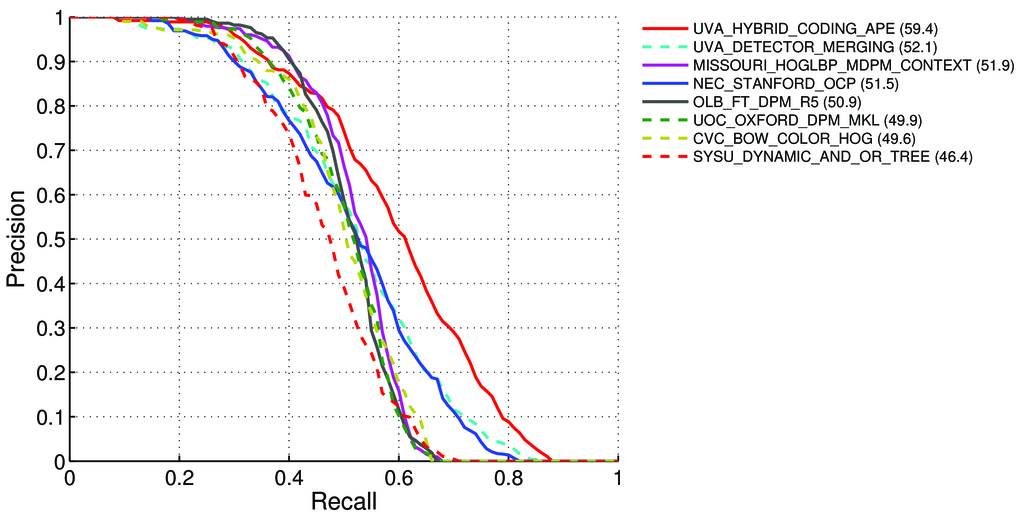How to calculate the mAP (mean Average Precision) for the detection task for the Pascal VOC leaderboards?
There said - at page 11:
Average Precision (AP). For the VOC2007 challenge, the interpolated average precision (Salton and Mcgill 1986) was used to evaluate both classification and detection. For a given task and class, the precision/recall curve is computed from a method’s ranked output. Recall is defined as the proportion of all positive examples ranked above a given rank. Precision is the proportion of all examples above that rank which are from the positive class. The AP summarises the shape of the precision/recall curve, and is defined as the mean precision at a set of eleven equally spaced recall levels [0,0.1,...,1]:
AP = 1/11 ∑ r∈{0,0.1,...,1} pinterp(r)The precision at each recall level r is interpolated by taking the maximum precision measured for a method for which the corresponding recall exceeds r:
pinterp(r) = max p(r˜), where p(r˜) is the measured precision at recall ˜r
About mAP
So does it mean that:
- We calculate Precision and Recall:
A) For many different
IoU> {0, 0.1, 0.2, 0.3, 0.4, 0.5, 0.6, 0.7, 0.8, 0.9, 1}we calculate True/False Positive/Negative valuesWhere
True positive = Number_of_detection with IoU > {0, 0.1,..., 1}, as said here and then we calculate:Precision = True positive / (True positive + False positive)Recall = True positive / (True positive + False negative)
B) Or for many different thresholds of detection algorithms we calculate:
Precision = True positive / (True positive + False positive)Recall = True positive / (True positive + False negative)Where
True positive = Number_of_detection with IoU > 0.5as said here
C) Or for many different thresholds of detection algorithms we calculate:
Precision = Intersect / Detected_boxRecall = Intersect / ObjectAs shown here?

- Then we calculate AP (average precision) as average of 11 values of
Precisionat the points whereRecall = {0, 0.1, 0.2, 0.3, 0.4, 0.5, 0.6, 0.7, 0.8, 0.9, 1}, i.e.AP = 1/11 ∑ recall∈{0,0.1,...,1} Precision(Recall)
(In general for each point, for example 0.3, we get MAX of Precision for Recall <= 0.3, instead of value of Precision at this point Recall=0.3)
- And when we calculate AP only for 1 something object class on all images - then we get AP (average precision) for this class, for example, only for
air.
So AP is a integral (area under the curve)
But when we calculate AP for all object classes on all images - then we get mAP (mean average precision) for all images dataset.
Questions:
- Is it right, and if it isn't, then how to calculate mAP for Pascal VOC Challenge?
- And which of the 3 formulas (A, B or C) is correct for calculating Precision and Recall, in paragraph 1?
Short answer:
- mAP = AVG(AP for each object class)
- AP = AVG(Precision for each of 11 Recalls {precision = 0, 0.1, ..., 1})
- PR-curve = Precision and Recall (for each Threshold that is in the Predictions bound-boxes)
- Precision = TP / (TP + FP)
- Recall = TP / (TP + FN)
- TP = number of detections with IoU>0.5
- FP = number of detections with IoU<=0.5 or detected more than once
- FN = number of objects that not detected or detected with IoU<=0.5

